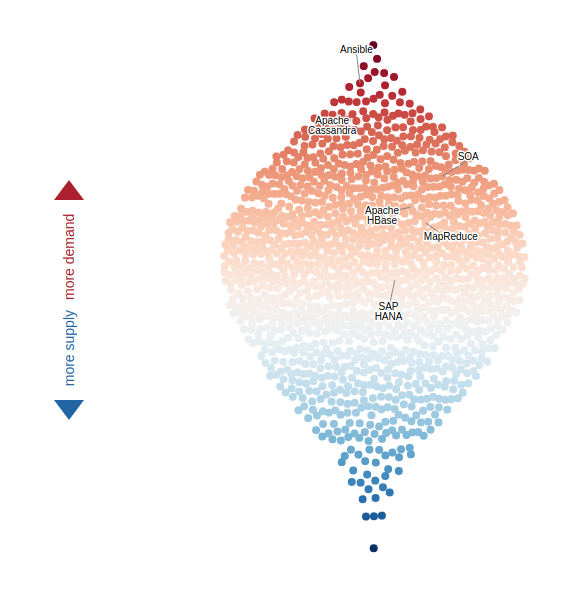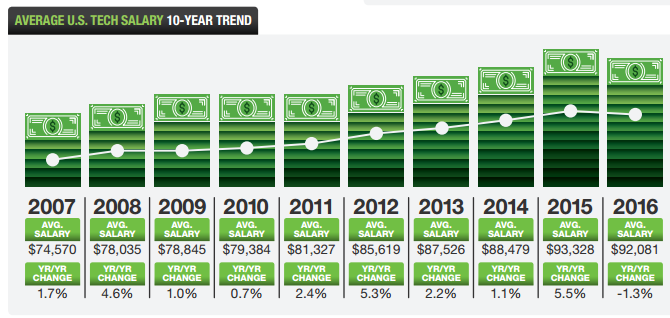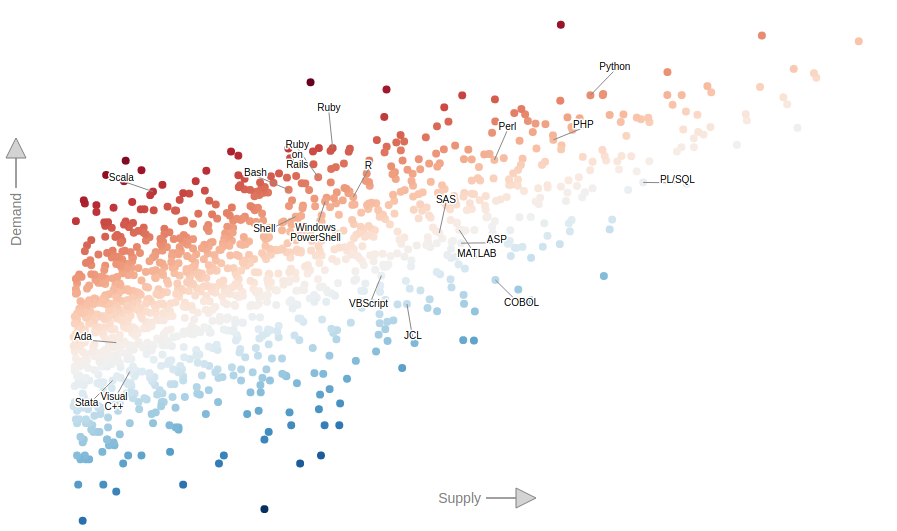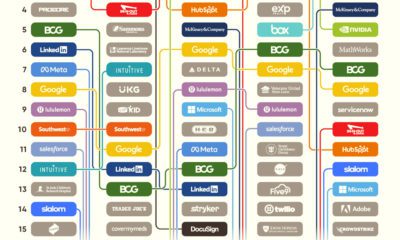Specifically, the supply shown on the graph is based on the amount of job seekers with those skills available, while demand is the portion of employment opportunities listed that require that skill. The “hotter” red a skill is, the greater the ratio of demand to supply.
Big Data Heats Up
With billions of new “things” connecting to the IoT and an explosion in the amount of information that must be processed and interpreted, it is no surprise that many of the most lucrative skills in tech today relate to making sense of large volumes of data.
Here are the ten highest paying skills in technology, according to Dice:
Leading the list is SAP’s HANA, or “High Performance Analytical Application”, which is part of a new wave of databases that can crunch large amounts of data nearly instantly. The average salaries of workers skilled in HANA currently hover around $129,000.
If we sort the members of the top ten most lucrative skills list by “heat” level (with several omissions according to availability in the “heat data” set) we can see that HANA is right in the middle of the plot, where supply is roughly equal to demand. This shows us that tech workers choosing to skill up in HANA are effectively getting paid what they are worth.
Defining the Essentials
What else does “heat” ranking tell us about the market for tech skills that salary data alone does not? First and foremost, it shows that skills like Java, SQL and HTML, all of which live in the top right-hand corner of the interactive graph where both demand and supply are very high, have become the “bread and butter” of the tech industry. The vast majority of people in the field have a need for these basic services, and as such, the majority of workers in tech have become conversant in them. We can also see that specific fields, like database administration, web infrastructure management, automation, and big data science, are the areas that businesses need the most help in. The number of specialists skilled in these fields has not yet expanded to meet the significant demand for the associated skills. On the other hand, many marketing and web design skills have fallen toward the “cold” side of the spectrum as supply exceeds demand.
Competition and Timing
Employers may often look for very specific skill sets including one or more of the “hot” skills in the current marketplace. Combined with a hot technology sector, this demand pushes average salary ranges up and motivates tech workers to continually revise their competencies on a regular basis.
With such a fluid marketplace for jobs in technology, unemployment is very low at around 2%. At the same time, over the past decade, the average tech salary has also increased by roughly $17,000. on But fast forward to the end of last week, and SVB was shuttered by regulators after a panic-induced bank run. So, how exactly did this happen? We dig in below.
Road to a Bank Run
SVB and its customers generally thrived during the low interest rate era, but as rates rose, SVB found itself more exposed to risk than a typical bank. Even so, at the end of 2022, the bank’s balance sheet showed no cause for alarm.
As well, the bank was viewed positively in a number of places. Most Wall Street analyst ratings were overwhelmingly positive on the bank’s stock, and Forbes had just added the bank to its Financial All-Stars list. Outward signs of trouble emerged on Wednesday, March 8th, when SVB surprised investors with news that the bank needed to raise more than $2 billion to shore up its balance sheet. The reaction from prominent venture capitalists was not positive, with Coatue Management, Union Square Ventures, and Peter Thiel’s Founders Fund moving to limit exposure to the 40-year-old bank. The influence of these firms is believed to have added fuel to the fire, and a bank run ensued. Also influencing decision making was the fact that SVB had the highest percentage of uninsured domestic deposits of all big banks. These totaled nearly $152 billion, or about 97% of all deposits. By the end of the day, customers had tried to withdraw $42 billion in deposits.
What Triggered the SVB Collapse?
While the collapse of SVB took place over the course of 44 hours, its roots trace back to the early pandemic years. In 2021, U.S. venture capital-backed companies raised a record $330 billion—double the amount seen in 2020. At the time, interest rates were at rock-bottom levels to help buoy the economy. Matt Levine sums up the situation well: “When interest rates are low everywhere, a dollar in 20 years is about as good as a dollar today, so a startup whose business model is “we will lose money for a decade building artificial intelligence, and then rake in lots of money in the far future” sounds pretty good. When interest rates are higher, a dollar today is better than a dollar tomorrow, so investors want cash flows. When interest rates were low for a long time, and suddenly become high, all the money that was rushing to your customers is suddenly cut off.” Source: Pitchbook Why is this important? During this time, SVB received billions of dollars from these venture-backed clients. In one year alone, their deposits increased 100%. They took these funds and invested them in longer-term bonds. As a result, this created a dangerous trap as the company expected rates would remain low. During this time, SVB invested in bonds at the top of the market. As interest rates rose higher and bond prices declined, SVB started taking major losses on their long-term bond holdings.
Losses Fueling a Liquidity Crunch
When SVB reported its fourth quarter results in early 2023, Moody’s Investor Service, a credit rating agency took notice. In early March, it said that SVB was at high risk for a downgrade due to its significant unrealized losses. In response, SVB looked to sell $2 billion of its investments at a loss to help boost liquidity for its struggling balance sheet. Soon, more hedge funds and venture investors realized SVB could be on thin ice. Depositors withdrew funds in droves, spurring a liquidity squeeze and prompting California regulators and the FDIC to step in and shut down the bank.
What Happens Now?
While much of SVB’s activity was focused on the tech sector, the bank’s shocking collapse has rattled a financial sector that is already on edge.
The four biggest U.S. banks lost a combined $52 billion the day before the SVB collapse. On Friday, other banking stocks saw double-digit drops, including Signature Bank (-23%), First Republic (-15%), and Silvergate Capital (-11%).
Source: Morningstar Direct. *Represents March 9 data, trading halted on March 10.
When the dust settles, it’s hard to predict the ripple effects that will emerge from this dramatic event. For investors, the Secretary of the Treasury Janet Yellen announced confidence in the banking system remaining resilient, noting that regulators have the proper tools in response to the issue.
But others have seen trouble brewing as far back as 2020 (or earlier) when commercial banking assets were skyrocketing and banks were buying bonds when rates were low.


















